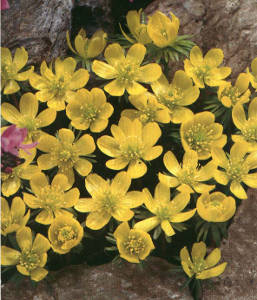

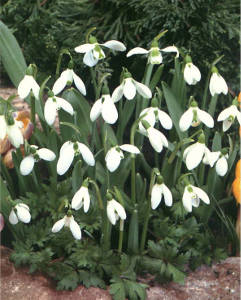

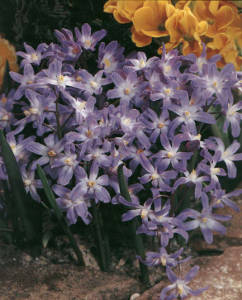

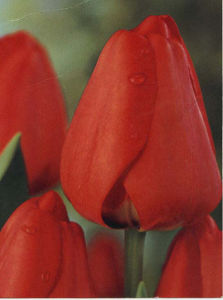

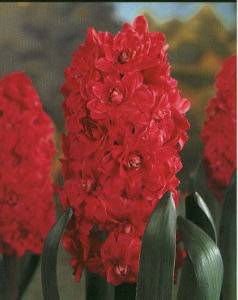

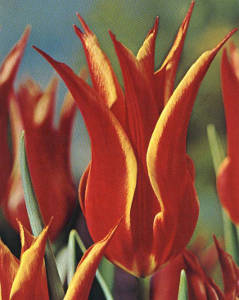

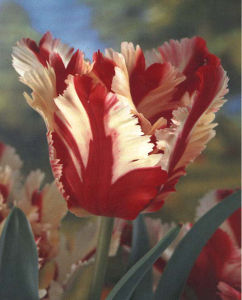

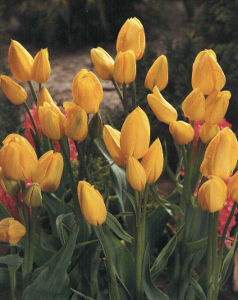

Spring flowering bulbs are truly the Harbingers of Spring. They bring us the hope of Spring after too long a winter. Winter Aconite will often be the first spring flowering bulb to peak out through the snow with it's bright yellow butter cup like flowers. They are closely followed by the Snowdrops (Galanthus). My favourite Snowdrop is the double flowering variety. Windflowers (Anemones) are the next to show up with their blue and white daisy like flowers. After this there is a riot of colour provided by a wide array of spring flowering bulbs.
To obtain a good consistent and continuous display of colour requires some fore thought. First location, location, location. Spring flowering bulbs come from a wide variety of backgrounds hence choosing the right spot is the first step of this successful journey. Most Spring flowering bulbs require high organic, well drained, slightly acidic (pH 6-7) soil in a sunny location. This means 6 to 8 hours of sunlight. To improve a soil whether it is too sandy or too heavy you must add organic material. The heavy soils usually require more organic soil amendments than the lighter ones. Heavy soils should receive 4 to 5 cubic feet of organic material per 100 square feet to a depth of 8 inches. If well aged composted manure is used then it should not be greater than 2 cubic feet per 100 square feet of the total amount of soil amendments. The addition of the soil amendments will help raise the soil surface and increase the all important drainage. This is must for your Botanical or species Tulips and Narcissi as they require perfect drainage. Never choose a low wet spot for Spring flowering bulbs unless you are planting Camassia. When planting Spring flowering bulbs under trees and I know you will, remember that the tree is a big bully who wants all the food, water and light. The result is plant where there is adequate light. This may require you to trim up or thin out the tree's branches. The roots must be kept clear of the Spring flowering bulbs because they will always win the battle for food, water and space. Under Evergreen Trees the pH will be slightly acidic and this acceptable to the Spring flowering bulbs. The best Spring flowering bulbs to plant under deciduous trees are those that flower and mature quickly before the trees leaves block out the sunlight. Good examples of these are Crocus, Winter Aconite, Snowdrops, and Scilla sibirica. If you wish to plant Spring flowering bulbs under turf grass then use Crocus. You can not cut the turf grass until the foliage has died down. This is very effective when they are planted in very large drifts. This naturalizing of small Spring flowering bulbs whether in the turf grass, in the garden or under trees should be at a rate of 20 minor Spring flowering bulbs per square foot. Naturalizing the small or minor Spring flowering bulbs in the garden you can use Grape Hyacinths, Scilla sibirica, Chionodoxas, Snowdrops and early species Crocus. Naturalizing never occurs with the large Tulips because they naturally deteriorate and should be replaced every few years. On the other hand Narcissuses are long lasting with most being excellent for naturalizing. Good examples are Narcissuses Carlton, Mount Hood and King Alfred.
Colour
Colour is a very personal matter. Just look at the colours your friends are wearing. So I will deal with this area briefly. First always pick the colour(s) you like. Remember to take into consideration the colours of the structures, surrounding plants, and if they going to bloom later in the season those of your annuals so as to avoid clashes. Also strong contrasts can be very effective but also over whelming.
Here are some combinations I like. Tulips Queen of the Night - White Triumphator, Golden Artist- Black Parrot, Red Emperor - Yellow Emperor, Red Emperor- King Alfred Daffodils, Golden Appledorn - Appledorn Elite, Prince Charles - Queen of the Night. The list could go on and on but I feel this should be suitable enough to start some heated debates.
Planting
STOP! The first mistake many people make is they plant their Spring flowering bulbs where they want to later plant their Annuals. It is important to plant your Spring flowering bulbs so that the Annuals you plant will grow up to cover the dying foliage of the Spring flowering bulbs. The general rule of planting bulbs is: the planting depth is 2.5 to 3 times the diameter of the bulb. Small or minor Spring flowering bulbs are planted with their tops 2 to 3 inches below the soil surface and 3 to 4 inches apart. The large Spring flowering bulbs are planted 6 to 8 inches below the soil surface and 8 inches apart. If you are running out of space and what gardener isn't you can stack your Spring flowering bulbs on top of each other. For example Late tall Tulips planted 8 inches down, mid-season mid height Tulips planted 6 inches down, Crocus 3 to 4 inches down. Try this Late tall Daffodils planted 8 inches down, Gregii Tulips planted 6 inches down, Winter Aconite 3 inches down. The soil should be worked up on the bottom of the hole and a fertilizer incorporated. The fertilizer could be Bone Meal, or a 5-10-5, or a 5-10-10 but my favourite is Holland Bulb Booster. Always follow the label directions. The fertilization of your Spring flowering bulbs at this time will show up as bigger stronger plants with larger flowers in the second season. The Spring flowering bulbs can be planted in a large hole or individually at the proper depth and spacing. In softer sandy soil a Dibber can be used to punch a hole and then insert the bulb down to the bottom of the hole. If Bushy Tailed Rats are a problem then plant your Spring flowering bulbs inside a chicken wire cage. Alternatively Ropellents can be added to your bulbs at planting time. The alternative is to plant Narcissus because the wee beastees will not eat them.
I like to plant my Spring flowering bulbs in this order. Narcissus (Daffodils), Hyacinths, Tulips, minor Spring flowering bulbs. When planting Spring flowering bulbs always plant in odd numbers. For example: 3,5,7,9,11. The closer you are to view the cluster the smaller the number in the cluster. So a cluster to be viewed at a great distance would most likely have 9 or 11 Spring flowering bulbs in it.
Maintenance
In the Spring as your Spring flowers bulbs emerge from the ground you should fertilize them with the afore mentioned fertilizers at the recommended rates. It is up to you but it is possible feed them again after you remove the spent flowers. Always ensure you remove not just the petals but the developing seed heads as well. This ensures that all the plant's energy is put into storing food for next years flowers. Do not remove any of the leaves. They must remain until they are yellowed and brown in order to make enough food to flower the following year.
Failure to Bloom
Spring flowering bulbs fail to bloom when the soil conditions are to wet, over crowded, not dead headed, or the foliage has been removed to soon or have received inadequate fertilization. Poor blooming Narcissus can be caused by any of the previous reasons as well as being planted to shallow or in very heavy clay soils. You can dig up your Spring flowering bulbs to correct some the problems. The bulbs are generally lifted and divided every 3 to 4 years to correct over crowding. It is usually safe to lift Tulips after June 25th and Narcissuses after July25th when the bulbs have matured. The minor or Small Spring flowering bulbs are done at various times after the their foliage has died down.
The Number 1 Question
The question I am always asked is, "What do I do with the Spring flowering bulbs that are shooting up to early?"
It is only the leaf tips that are showing above the ground not the flower buds so do absolutely nothing!
And Some Others
In the autumn we can also plant some hardy Fall blooming bulbs. These Fall flowering bulbs will usually bloom the next autumn after you plant them. These Fall flowering bulbs have leaves from April until July after which they die off. On the other hand the Hardy Cyclamen growing in my garden gets it's leaves in November and retains them until June and then they die down. The Fall flowering bulbs will usually bloom without any leaves in August, September or October. A few good examples of these Fall flowering bulbs are Crocus zonatus, Cyclamen neapolitanum, Colchicum.




